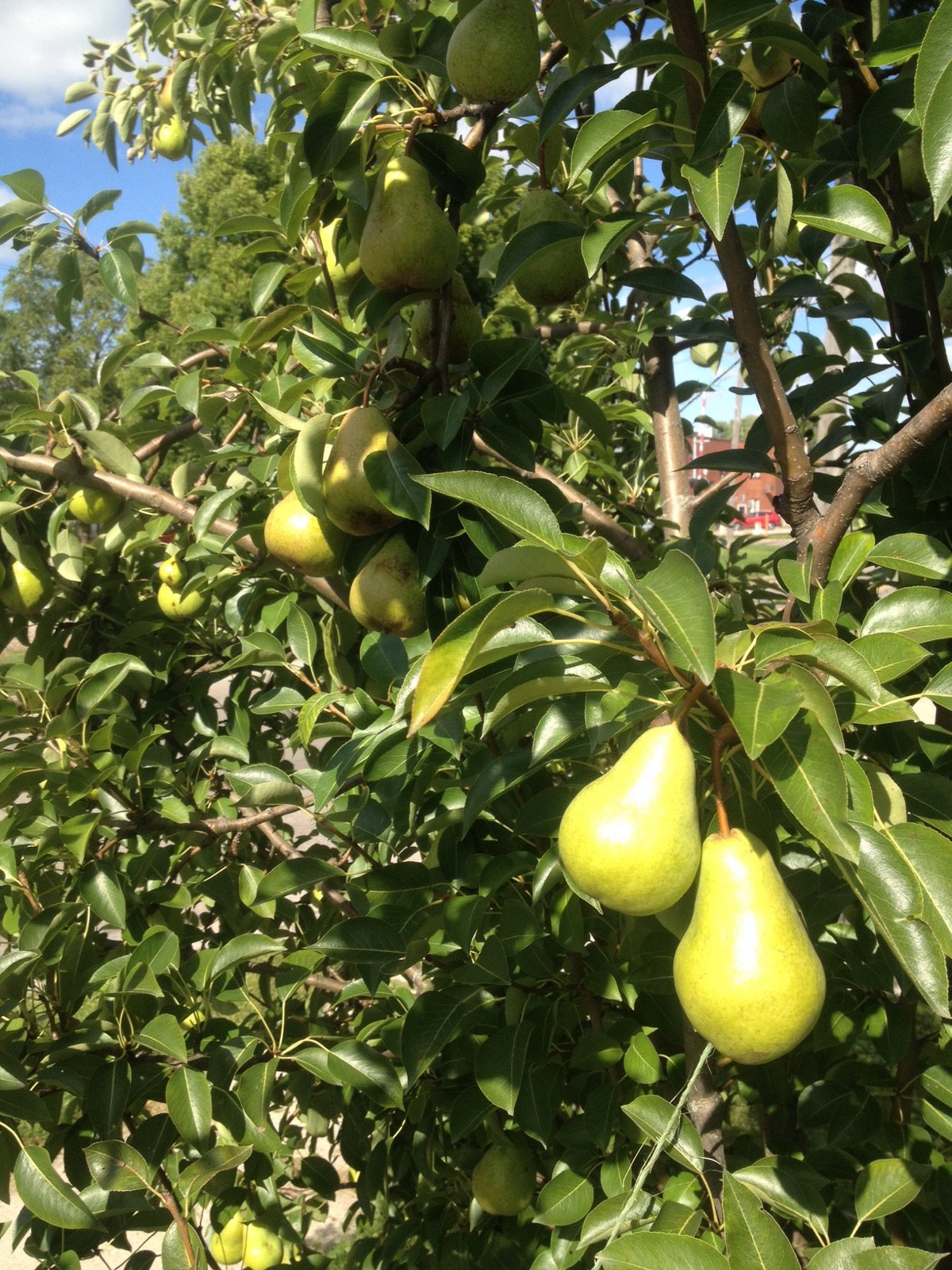European Pear Trees
Pyrus communis
A pear tree is an excellent addition to the backyard or orchard. Although slow to start bearing, pears are hardy and reliable producers requiring less attention than most other types of fruit trees. While some pears are partially self fertile, we recommend planting at least two different cultivars for reliable pollination; European and Asian pears do cross pollinate. Pears ripen from the inside out, and therefore typically should be picked when the fruit is still a bit hard. They then can fully ripen off the tree - especially important if it is a winter pear. A slight softening at the stem end will indicate the fruit ripe.
Sort by:
36 products
36 products
Available only for pick-up at nursery.
History: Flemish Beauty originated in Belgium in the early 1800s. At one point Flemish Beauty was one of the most common commercial varieties in the US.
Why We Grow It: Flemish Beauty's cold hardiness and good flavour makes this a popular variety. The fruit is large and greenish-yellow without much neck. It is known for being sweet and very juicy, great for fresh eating.
Available only for pick-up at nursery.
History: Harrow Delight, as the name suggests, was introduced from the pear breeding program at the Harrow Research and Development Center in Ontario in 1981. It is a cross between Bartlett and Purdue 80-51, making it a sibling to Harrow Sweet.
Why We Grow It: Harrow Delight pears are green with red blush when mature. They have sweet, juicy flesh and keep about a month. The tree boasts resistance to both fireblight and scab, making it a good option for anyone looking for a more disease resistant pear variety.
Available only for pick-up at nursery.
History: Summercrisp pears were developed by the University of Minnesota in an effort to create a cold hardy pear. They were successful in creating a hardy and delicious pear, releasing the variety in 1985. Its name is derived from the fact it ripens in summer (very early for a pear!) and that it is great right off the tree when still crisp.
Why We Grow It: Summercrisp performs amazingly in our test orchard, producing lots of freckled beauties that ripen uniformly and hang well on the tree. This early cold-hardy pear has a really sweet, pleasant flavour and is not gritty or dry. The fruit are average-sized with yellow skin and red blush. For optimal eating they should be picked before fully ripe and stored in the fridge until eating. This variety deserves to be more widely planted.
Available only for pick-up at nursery.
Species: xSorbopyrus irregularis (Pyrus communis x Sorbus aria), also referred to as xSorbopyrus auricularis although this name is no longer correct
History: Shipova is a unique cross between European pears and Common Whitebeam* (Sorbus aria) which readily hybridizes with many other fruiting plants in the rose family. As a surprise hybrid, the history of Shipova is a little foggy. This cross supposedly appeared, or was perhaps planted, at Bollwiller Castle in France in the 1600s and was called Bollwiller Pear. It was cultivated in gardens in the late 1700s and early 1900s. It may have also originated in Yugoslavia and is popular in Eastern Europe today. Shipova was first brought to the US in 1959 and was imported from Yugoslavia. Today, it appears to remain something of a novelty in North America.
Why We Grow It: Shipova is a truly unique fruit tree and it is a shame that it is not grown more commonly. They are quite cold hardy and relatively disease-resistant. The trees produce clusters of small, round fruit that resemble pears. They are dense and crisp with a sweet flavour reminiscent of tropical fruits.
*Many places list Shipova as a cross between European pears and Mountain Ash. More precisely, the genus Sorbus is the Mountain Ash genus and the specific tree that is the parent of Shipova is the species Sorbus aria, commonly known as Common Whitebeam
Available only for pick-up at nursery.
History: Vicar of Winkfield was discovered growing as a wild seedling in the woods near Villiers-en-Brenne in France around 1760. It was originally named Curé (translated from French as 'priest') among other names but became known as Vicar of Winkfield when a vicar of the English village Winkfield named Rev. W.L. Rahm introduced the variety to England. It is a heritage cooking pear and can still be found in old French orchards today.
Why We Grow It: This long, yellowish-green pear is best known for its use in cooking and baking due to its uniquely dry flesh and more tart flavour. Vicar of Winkfield can be stored for several months and will develop a sweeter flavour over time. It is generally recommended to store the pear until after Christmas for fresh eating! The tree is vigorous and produces abundant crops.
History: Barnet's history is somewhat of a mystery although we know it likely originated in Gloucester, England in the 1800s and was distributed by the Long Ashton Research Station in the 1900s. It is a traditional perry pear that is known by many names including Barn, Brown Thorn, and, adorably, Hedgehog. The last name is speculated to come from the fruit's resemblance to baby hedgehogs (aka hoglets) nestling in the grass.
Why We Grow It: Barnet produces small, brown russetted fruit that are quite juicy. The juice is quite mild since it is low in both tannins and acidity, making it a good choice for adding to perry blends. The ripe fruit is easily shaken from the tree for ease of harvest.
Showing 36/36






